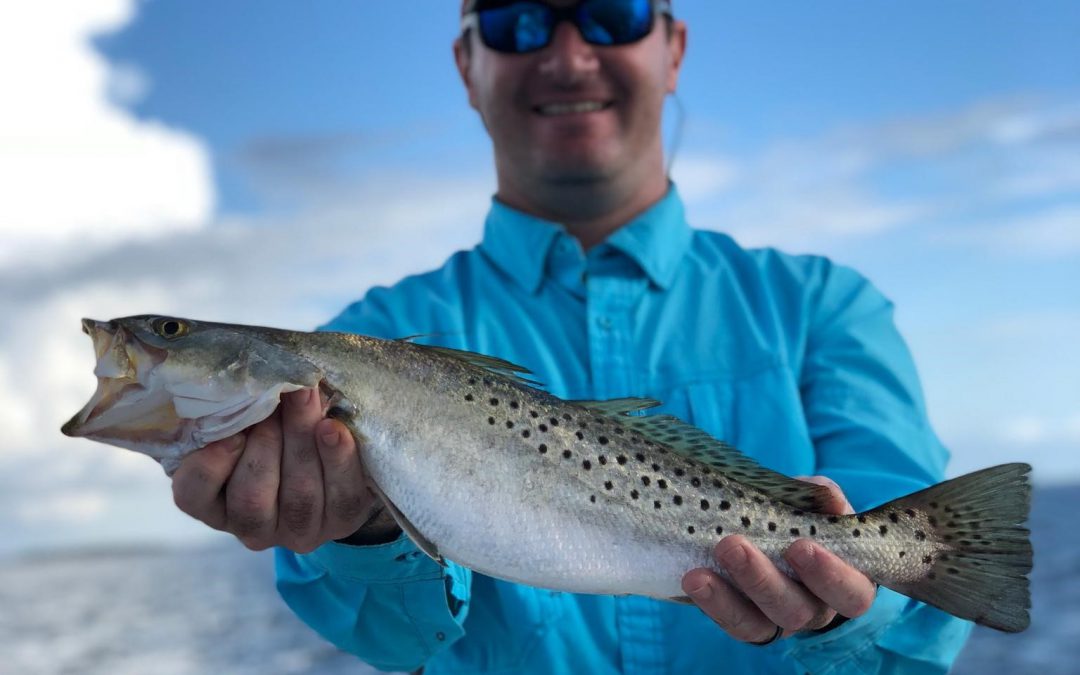
by Mark Mauldin | Feb 5, 2021
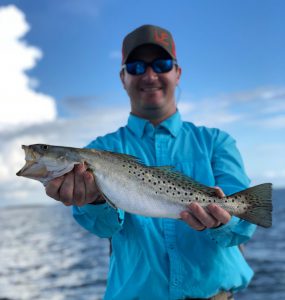
Reminder: Spotted seatrout harvest is closed in the Western Panhandle Management Zone the entire month of February.
New regulations were put into place last year reducing bag limits and closing harvest during February in the Western Panhandle Management Zone. For more details see my previous post on the subject.When Spotted Seatrout season is open (months other than February) in the Western Panhandle Management Zone the daily bag limit is 3 per harvester. Harvested Spotted Seatrout must be more than 15 inches long and less than 19 inches long. One fish, per vessel, over 19 inches my be included in the bag limit.
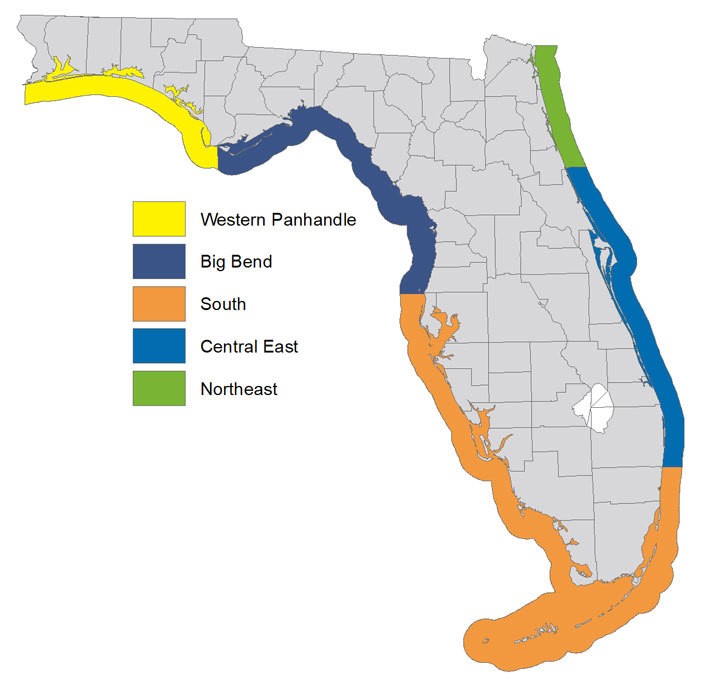
The Western Panhandle Spotted Seatrout Management Zone includes the State and federal waters of Escambia County through the portions of Gulf County west of longitude 85 degrees, 13.76 minutes but NOT including Indian Pass/Indian Lagoon.
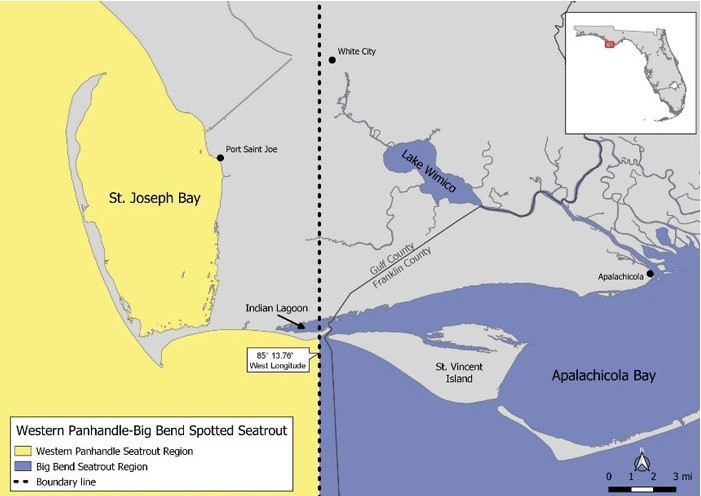
Boundary between the Western Panhandle and Big Bend spotted seatrout management zones.
Image source: www.myfwc.com
See myfwc.com for complete information on all game and fish regulations in Florida.
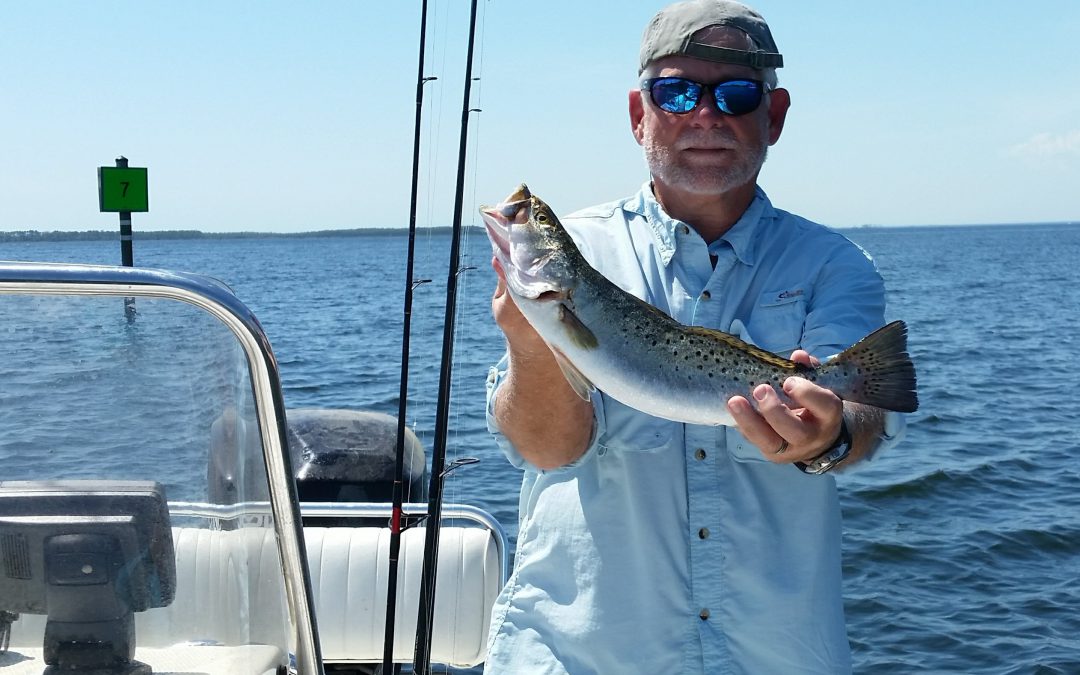
by Mark Mauldin | Feb 28, 2020
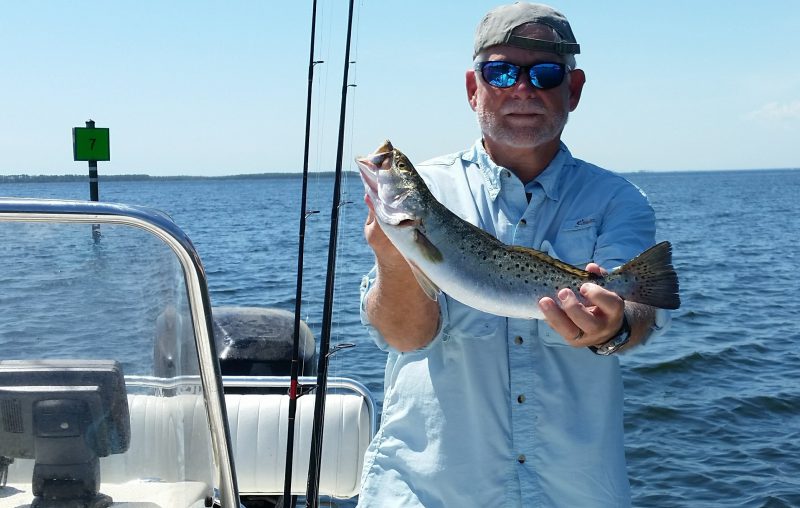
A spotted seatrout caught last summer in the St. Andrew’s Bay system (an area now included in the new Western Panhandle Management Zone).
Photo credit: Mark Mauldin
Recently FWC (Florida Fish & Wildlife Conservation Commission) announced rule changes relating to spotted seatrout.
The text was taken directly from FWC press releases; details not pertinent to NW Florida were removed.
Several rule changes for spotted seatrout [went] into effect Feb. 1, including a closure to spotted seatrout harvest in the new Western Panhandle management zone. Spotted seatrout are one of Florida’s most popular inshore fisheries. The Florida Fish and Wildlife Conservation Commission (FWC) made these changes after reviewing the results of a recent stock assessment and gathering input from anglers. These changes were made to benefit spotted seatrout populations while continuing to provide quality fishing opportunities.
The following rules [went] into effect Feb. 1, 2020:
- Creating two new zones by splitting the Northwest spotted seatrout management zone into the: (See maps below.)
- Western Panhandle (Escambia County through the portions of Gulf County west of longitude 85 degrees, 13.76 minutes but NOT including Indian Pass/Indian Lagoon).
- Big Bend (remaining portion of Gulf County plus Indian Lagoon, and Franklin County through Fred Howard Park Causeway in Pinellas County).
- Reducing bag limits
- Western Panhandle: three fish (was five).
- Big Bend: five fish (no change).
- Modifying the recreational slot size limit from 15-to-20 inches to 15-to-19 inches total length.
- Allowing one seatrout over 19 inches per vessel (currently per harvester).
- Prohibiting captain and crew from keeping a bag limit on a for-hire trip.
- Re-establishing the February recreational closure in the Western Panhandle zone.
Learn more about spotted seatrout by visiting MyFWC.com/Marine and clicking on “Recreational Regulations” and “Spotted Seatrout.”

Newly-approved FWC Spotted seatraout management zones, effective February 1, 2020
Image source: www.myfwc.com

New boundary between the Western Panhandle and Big Bend spotted seatrout management zones effective Feb. 1, 2020.
Image source: www.myfwc.com
Earlier this week Governor DeSantis announced the dates for the 2020 Gulf Red Snapper Season – June 11 through July 25.
Governor Ron DeSantis Announces 2020 Gulf Red Snapper Season
Tallahassee, Fla. – Today, Governor Ron DeSantis announced the popular 2020 Gulf red snapper recreational season is set to open June 11 through July 25, with a possible fall reopening if quota is available. This season will apply to those fishing from private recreational vessels in Gulf state and federal waters, and to charter vessels that do not have a federal reef fish permit and are limited to fishing in state waters only.
Earlier this month, Florida was delegated authority to manage recreational red snapper harvest from private vessels in Gulf federal waters.
“I’m pleased to announce that our state’s good conservation practices are allowing us to have a 45-day Gulf red snapper season this year,” said Governor DeSantis. “Gulf red snapper season is always an exciting time for anglers and is just another reason why Florida remains the Fishing Capital of the World.”
“Gulf red snapper is a conservation and management success story for Florida anglers,” said Florida Fish and Wildlife Conservation Commission (FWC) chairman Robert Spottswood. “Just a few years ago, a 45-day season for red snapper in both state and federal waters was out of reach. Thank you to all the stakeholders and anglers who helped make this season possible by providing input and sharing information about their fishing trips.”
“FWC is proud to be able to work with our stakeholders to balance conservation with fishing opportunities for Gulf red snapper and we are excited to see what the future holds as FWC takes the unprecedented step of managing this resource in both state and federal waters of the Gulf,” said Spottswood.
For more on recreational snapper regulations, visit MyFWC.com/Marine and click on “Recreational Regulations” and “Snapper” under the “Reef Fish” tab.
Follow the link for more information on Snapper fishing in Florida – FWC Snappers
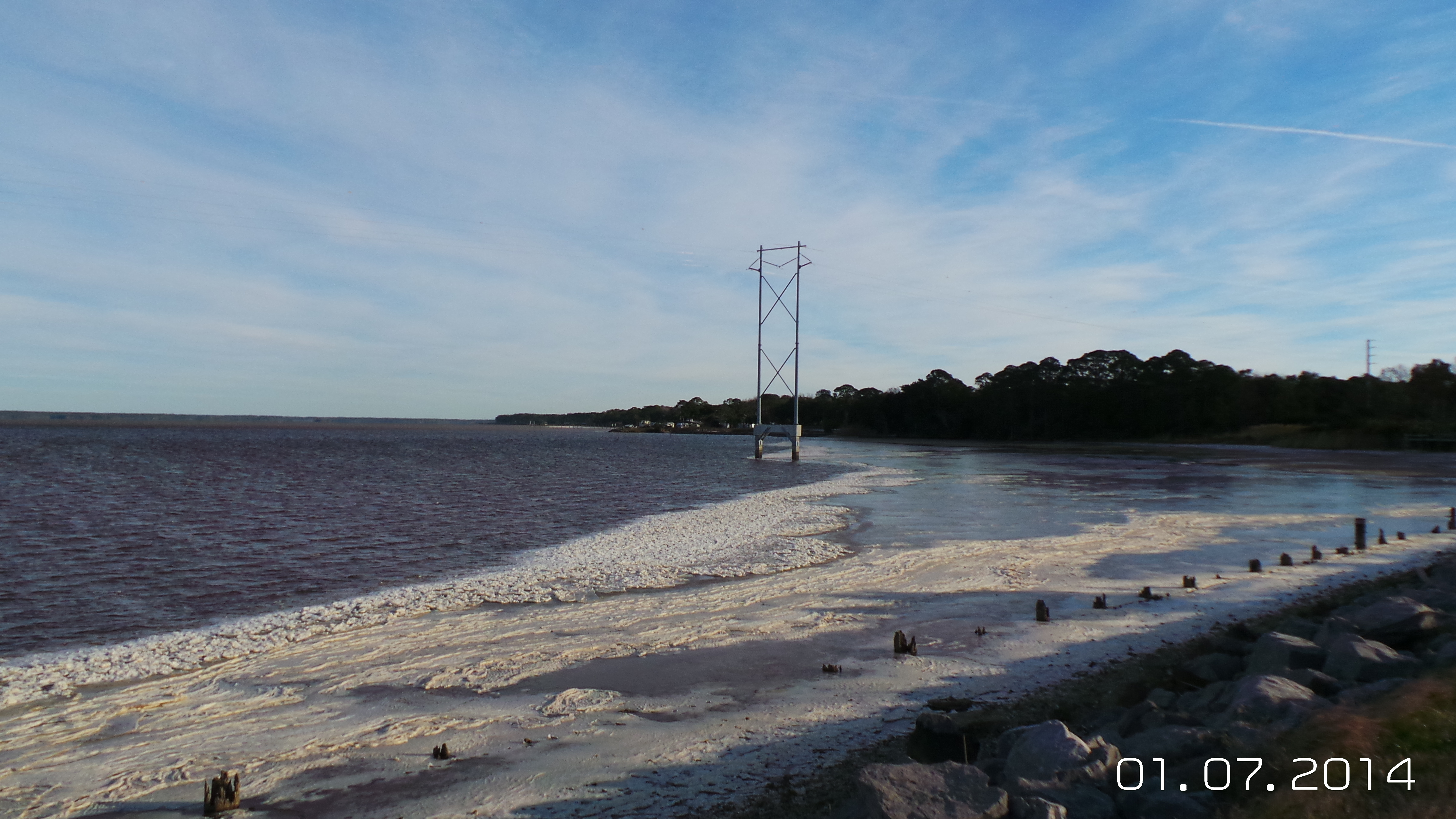
by Chris Verlinde | Jan 25, 2014
With the ongoing cold weather across the Panhandle, fish kills are being reported in many areas.
In the Panhandle, average water temperatures have dropped down to the 50s (degrees Fahrenheit) in many waterbodies. This is about ten degrees cooler than in normal years. Fish have a tolerance to temperature but when air and water temperatures decrease rapidly, fish kills may occur.
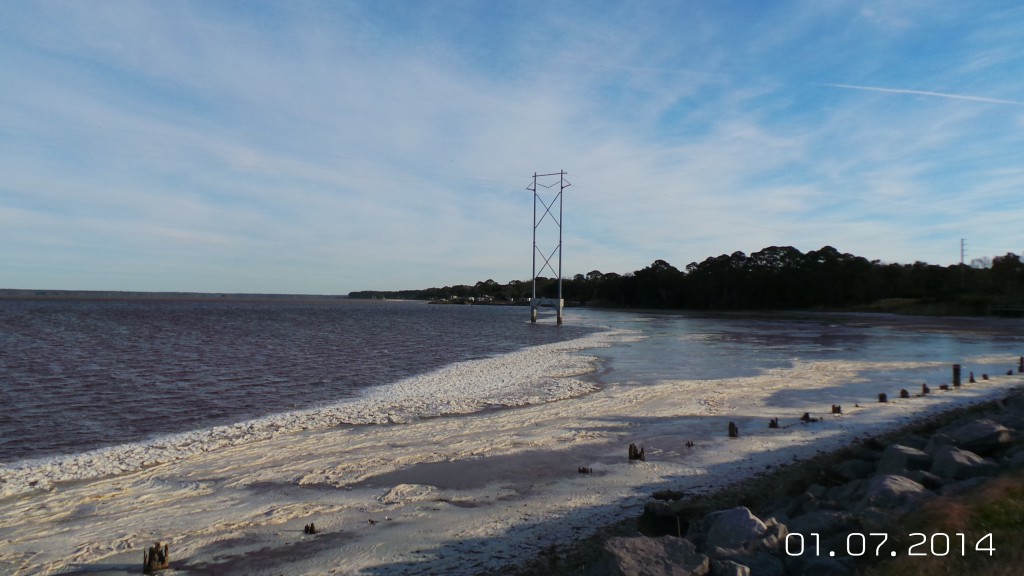
Recent ice coverage in Apalachicola Bay is visible example of the harsh environmental conditions that have led to reported fish kills throughout Florida, including the Panhandle. Photo by L. Scott Jackson
Fish kills due to cold weather are naturally occurring phenomena. In some cases there may be an ecological benefit. Exotic fish species that have adapted to Florida’s subtropical climate may not be able to withstand these colder temperatures and large numbers of the populations may be eliminated. The decrease in the population of exotic species may allow for an increase in native populations.
The Florida Fish and Wildlife Conservation Commission’s (FWC) Fish Kill Hotline provides maps of fish kills throughout the state on a monthly basis. If you see a fish kill you can report it by phone: 1-800-636-0511 or online.
The FWC Fish Kill Website also allows the user to report fish kills and search the current database for fish kills by dates, county and possible causes of fish kills. (See example search below)
Your search was:
- From 12/01/2013
- To 01/24/2014
- All Counties
- Suspected Causes Cold Weather
Note: Select an Asterisked (*) Column Heading to Sort by That Column
| *ID |
Report
Number |
*Date
Reported |
City |
*County |
Call
Category |
*Probable
Cause |
Water
Body Name |
Specimen
Count |
| Comments |
| 20048 |
122013 |
12/20/2013 |
Lakeland |
Polk |
Fish Kill |
Cold Weather |
N Pkwy Frontage Rd & Carabbean Rd |
100s |
| Species Unidentified |
| 20051 |
122713 |
12/27/2013 |
Treasure Island |
Pinellas |
Mortality – Mollusca |
Cold Weather |
West Gulf Blvd |
100s |
| Conch |
| 20057 |
010214 |
1/2/2014 |
North Port |
Sarasota |
Fish Kill |
Cold Weather |
El Prada West |
100s |
| Sucker Mouth Catfish |
| 20064 |
010814 |
1/8/2014 |
Tarpon Springs |
Pinellas |
Mortality – Cartilaginous |
Cold Weather |
Anclote River Boat Ramp |
100s |
| Hammerhead Shark, Jack Crevalle, Pompano, Permit |
| 20065 |
010814 |
1/8/2014 |
Panacea |
Wakula |
Fish Kill |
Cold Weather |
Lake Tucker / Alligator Point |
100s |
| Trout, Sheepshead |
| 20067 |
011014 |
1/10/2014 |
Fort Walton Beach |
Okaloosa |
Fish Kill |
Cold Weather |
Cinco Bayou |
100s |
| Species Unidentified, Silverback, Yellow Bellie |
| 20068 |
011214 |
1/12/2014 |
Palm Harbor |
Pinellas |
Fish Kill |
Cold Weather |
Anclote – Between Marker 32 & 36 |
Unknown Count |
| Unknown Count |
| 20069 |
011214 |
1/12/2014 |
Tarpon Springs |
Pinellas |
Fish Kill |
Cold Weather |
Anclote – N Pointe Alexis Dr |
Unknown Count |
| Jack Crevalle, Permit |
| 20070 |
011214 |
1/12/2014 |
Lecanto |
Citrus |
Fish Kill |
Cold Weather |
Creek Off Pirates Cove |
10 |
| Snook |
| 20071 |
011314 |
1/13/2014 |
New Port Richey |
Pinellas |
Fish Kill |
Cold Weather |
1/4 Mile S Anclote Key |
100s |
| Jack Crevalle, Trout |
| 20073 |
011314 |
1/13/2014 |
Crystal River |
Pasco |
Fish Kill |
Cold Weather |
East of Power Plant |
Unknown Count |
| Jack Crevalle, Pompano |
| 20085 |
011814 |
1/18/2014 |
Pensacola |
Escambia |
Fish Kill |
Cold Weather |
Heron Villa Lane – Perdido Bay |
100 |
| Species Unidentified |
| 20090 |
012114 |
1/21/2014 |
Pensacola |
Escambia |
Fish Kill |
Cold Weather |
Riola Lane/Perdido Bay |
Unknown Count |
| Species Unidentified |
|

Above is an example of the December 2013 reported fish kill map:
There are a number of reasons for fish kills besides cold temperatures; low dissolved oxygen levels, spawning fatalities, diseases and parasites, algae blooms and human induced fish kills.
To report a fish kill to the FWC Fish Kill hotline, you will need information such as the name of the water body, whether the water is fresh, brackish or saltwater, observations of the characteristics of the water, species and number of fish that are observed (if you don’t know the species, you can check unknown), condition of the fish and if there are any abnormalities such as lesions, etc. on the fish.
If there are too many fish to count, estimate the total number by counting how many fish are in a 10’ x 10’ area, then estimate the total area that fish are present (along the shoreline and out into the water). Estimate how many 10’ x 10’ areas would fit into the total area, and multiply that number by the number of fish in the original 10’ x 10’ area. This will give you an estimate of the total number of fish.
Make a note of the weather conditions the past few days, air temperature, rainfall, cloud cover, wind strength and directions. Talk to your neighbors to determine if they have noticed anything unusual about the waterbody in the last few days.
For more information on understanding and reporting fish kills check out this publication from the University of Florida IFAS Extension:










